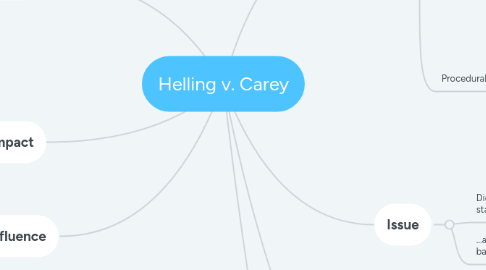
1. Conclusion
1.1. The court ignored the expert testimony regarding standard of care and ruled that Drs. Laughlin & Carey were negligent and therefore liable by virtue of violating a reasonably prudent physician
1.1.1. Determined that although the risk is 1 in 25,000 to those under 40, that one person deserves the same consideration, especially as blindness is the biggest risk
1.1.2. Ruled that it is up to courts to decide the the acceptable risk
2. Impact
2.1. Cases citing Helling v. Carey
2.1.1. Harrison v. Parke-Davis, Inc.
2.1.1.1. Ruling in this case used Helling case as a cornerstone of defining negligence with regards to standards of care
2.1.2. Ranger Ins. Co. v. Pierce County
2.1.2.1. Ruling in this case used Helling case as a cornerstone of bringing a malpractice case on virtue of reasonably prudent physician
3. Influence
3.1. It is important to consider that common sense rules with regards to certain areas of business, especially in the medical field
3.2. Just because a standard of care is accepted and followed does not always mean it is carte blanche and will apply the same in each situation
3.3. Risks must always be weighed prudently against benefits
4. Facts
4.1. Parties
4.1.1. Opthamologists Drs. Laughlin & Carey
4.1.2. Barbara Helling, patient of above physicians
4.2. What Happened
4.2.1. Helling complained of vision problems and sought evaluation from Drs. Laughlin & Carey
4.2.1.1. Contact lenses were prescribed
4.2.1.1.1. Vision problems persisted and Helling continued to be evaluated by Laughlin & Carey
4.2.1.1.2. Eventually, tonometry test was performed (after five years) and subsequent evaluation showed presence of glaucoma
4.2.1.1.3. By this time, Helling had significant loss of peripheral and central vision
4.2.2. Drs. Laughlin & Carey did not perform tonometry test on Ms. Helling (age 32) for glaucoma due to her relatively low risk based on age assessment
4.3. Procedural History
4.3.1. Helling filed suit against Drs. Laughlin & Carey for failure to conduct glaucoma test despite her complaints and alleged they were the direct cause of her vision decline via negligence
4.3.1.1. Court found in favor of Drs. Laughlin & Carey ruling that they upheld the standard of care
4.3.1.1.1. Helling appealed the ruling
5. Issue
5.1. Did Drs. Laughlin & Carey uphold the standard of care...
5.2. ...and if so, do they still incur any liability based on negligence claims?
6. Rule of Law
6.1. Medical Liability and Insurance Improvement Act
6.2. Common Law, Reasonably Prudent Physician
7. Application
7.1. Standard of Care
7.1.1. Defendants argued that they upheld the standard of care as glaucoma test is only recommended for patients over 40 due to the incidence and risk assessment; expense of the test is not justified
7.1.1.1. Multiple medical experts testified to this standard of care
7.2. Negligence
7.2.1. Helling argued that standard of care was lacking and was more cost-effective to test in under 40s via its own cost/benefit analysis
7.2.2. With regards to aspects of negligence in this case, the one the is at the foundation of this case in question is direliction of duty:
7.2.2.1. Duty - established
7.2.2.2. Direliction of Duty - plaintiff must prove that defendant did not uphold the standard of care via expert testimony regarding the professional standard and the clear breach of this standard
7.2.2.3. Direct Causation - established
7.2.2.4. Damages - established
7.3. Reasonably Prudent Physician
7.3.1. Although complying with the accepted standard of care with regards to glaucoma screening and testing at the time, a reasonably prudent physician should recognize the complaints made by a patient with regards to a deteriorating condition
7.3.1.1. The multiple complaints by Helling and continued lack of testing is negligent on the part of Drs. Laughlin & Carey
7.3.1.2. Court argued that the test is cost-effective and reasonable when a patient is potentially at risk especially in the case of mitigating a life-threatening condition

